Greater noctule bat facts for kids
Quick facts for kids Greater noctule bat |
|
|---|---|
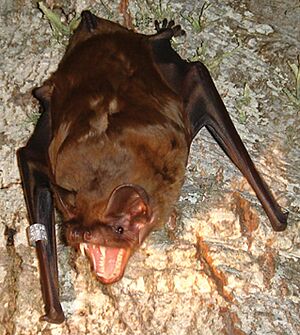 |
|
| Nyctalus lasiopterus showing its large teeth | |
| Conservation status | |
| Scientific classification | |
| Genus: |
Nyctalus
|
| Species: |
lasiopterus
|
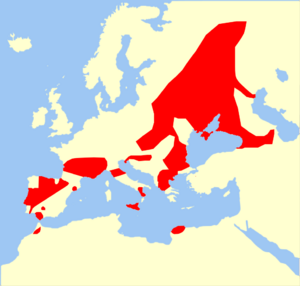 |
|
| Nyctalus lasiopterus range map | |
The greater noctule bat (Nyctalus lasiopterus) is a rare bat that eats meat. It lives in Europe, West Asia, and North Africa. This bat is Europe's biggest, with wings that can spread up to 46 centimetres (18 in) wide. We are still learning a lot about it. It is one of the few bats that hunts small passerine birds. What makes it special is that it catches birds while they are flying, not when they are resting. The greater noctule bat has wings made for hunting in open spaces. It uses echolocation (special sounds) that birds cannot hear.
Contents
About the Greater Noctule Bat
The greater noctule bat is part of a group called Yangochiroptera. Like many bats, it uses echolocation. Echolocation is like a natural sonar system. The bat sends out high-pitched sounds that we cannot hear. These sounds bounce off objects and come back as echoes. By listening to these echoes, the bat creates a detailed picture of its surroundings. This helps it find, locate, and identify its prey even in total darkness. Greater noctule bats usually leave their roosts only after it is completely dark. They have excellent hearing and a strong sense of smell, but their eyesight is not very good.
The wings of the greater noctule bat are thinner than bird wings. This allows the bat to move very quickly and precisely in the air. Even though their wings are delicate and can tear easily, they can grow back. The greater noctule is the largest bat in Europe. Its wingspan is usually between 41–46 cm (16–18 in). Its body is about 8.4 to 10.4 cm (3.3 to 4.1 in) long, and its tail is 5.5 to 6.6 cm (2.2 to 2.6 in) long. Its forearm, which is part of its wing, measures 6.2 to 6.8 cm (2.4 to 2.7 in). Adult bats weigh from 41 to 76 g (1.4 to 2.7 oz). These bats can fly very high up in the sky. They also hunt for food closer to the ground. Their fur is a reddish-brown to dark brown color. They have a wide snout and large, short ears. A part of their ear, called the tragus (ear), is broad and shaped like a mushroom.
Where They Live
The greater noctule bat lives in trees all year round. You can find them in the forests of Europe, from Spain all the way to Turkey. The largest number of these bats live in southwestern Spain. They really like oak or beech trees that have hollow spaces inside. These hollows are perfect for them to rest during the day. If there are no other options, they might also roost in pine trees. Some studies suggest they prefer birch trees. This might mean they do not have a favorite tree type. Instead, they might look for trees with the right physical conditions. Different trees might serve different purposes for the bats. For example, some trees might be better for resting, and others for raising young. Studies in Hungary show that greater noctules prefer roosting in high places. They also seem to like older, decayed trees.
What They Eat
Most bats that eat meat usually eat insects. However, greater noctule bats regularly hunt and eat birds. One study found that birds make up over 80% of their diet when birds are migrating. This shows that the greater noctule bat changes its diet based on what food is available. It is also one of the only bats known to hunt birds while they are flying. The only other possible one is the Asian great evening bat.
The greater noctule bat is very good at catching passerine birds in the air. It is a large bat with a wingspan of up to 46 centimeters. Its wings are designed for hunting in open spaces. It also uses echolocation with sounds that birds cannot hear. This gives the bat a secret advantage when hunting.
Mating and Life Cycle
We do not know much about the greater noctule bat's mating habits or how they reproduce. This is because they are quite rare and hard to study. Like other Nyctalus species, these bats can travel long distances. This means the number of males and females in an area can change a lot during different seasons. Studies in Hungary show that the male-to-female ratio varies by location. In some places like Greece and the Czech Republic, there are more males. In other places like Germany and Hungary, there are more females.
This difference might be because males and females have different needs for warmth and energy. Females prefer warmer places. This is better for their babies to grow and for them to produce milk. Males prefer cooler places because they need less energy. These studies have confirmed that female greater noctule bats have nursing colonies (places where they raise their young) in Hungary.
How They Interact with Their Environment
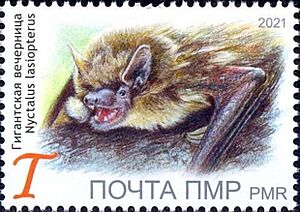
Greater noctule bats live in groups called fission-fusion societies. This means their group size can change. They have a social order and a territory in a specific group of trees. These trees are used for resting and raising young. Studies using radio tracking have shown that these bats travel between several roosting sites. They also participate in different social groups. It is thought that a bat's social rank might decide its role in the group. For example, some bats might be scouts, and others might be hunters. Bats with a higher social rank tend to have a smaller home range.
The greater noctule bat has a very large active range, about 2500 square kilometers. This is one of the biggest ranges for any bat species. This large area affects how they find food and where they rest. Changes made by humans to the environment might force these bats to travel more. They might need to fly further to find enough food. If there are not enough roosting sites near food sources, this could explain their large home range. Studies comparing bats in Great Britain and Spain show that they do not travel long distances for food unless they have to. This need to fly far for food might be a reason why their numbers are decreasing. One bat was even found exhausted on the ground from flying too much. Also, owl droppings found near bat roosts show that owls sometimes catch these bats while they are flying.
The area a greater noctule bat searches for food increases when females are nursing their young. This is likely because they need more energy. They also increase their foraging range when there is less food available. In summer and fall, when water levels and insects are lower in northern Europe, these bats fly south. They go to areas where there are more insects. The greater noctule bat is also one of the few bats that hunts birds migrating at night. These birds often stop to rest during the day in marshy fields. At night, the bats hunt for insects in these same fields. When the birds start migrating again at dusk, the bats are known to catch them in flight. These changes in habitat based on food show that the greater noctule bat relies heavily on places with enough food. They will travel far to find it.
Greater noctule bats also interact with parasites that live in their roosting trees. These parasites can transfer to the bats while they are sleeping. The bats also interact with nocturnal predators, mainly owls. Owl pellets have been found with greater noctule bat bones inside them.
Threats to Their Survival
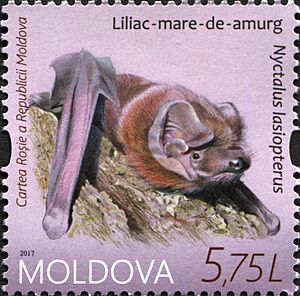
The main predators of the greater noctule bat are the barn owl (Tyto alba) and the Eurasian eagle-owl (Bubo bubo). Greater noctule bats usually leave their roosts to hunt after dark. This is the same time these two owl species hunt. There is also a risk of parasites spreading between bats.
In Seville, Spain, there is one of Europe's largest breeding colonies of these bats. Here, the bats are in danger. Rose-ringed parakeets (Psittacula krameri) are an invasive species. They compete with the bats for homes in tree hollows. These parakeets will even attack and kill adult bats to take over their habitat. Researchers have seen an 81% decrease in trees used by the bats in this area.
Protecting the Greater Noctule Bat
The greater noctule bat is currently listed as a Vulnerable species. This means it is at risk of becoming endangered. The IUCN Red List of Threatened Species classifies it this way. In Spain, it is also classified as 'vulnerable'. No other country in Europe has a specific endangered status for this bat.
Ideas for Conservation
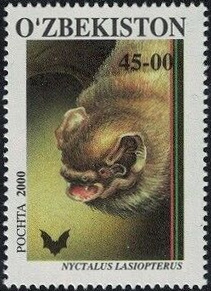
Greater noctule bats live in social groups and use several roosts. A colony might have one main roost and several smaller ones. Other bat species might even share these smaller roosts. These roosts help bats share information. However, they can also spread diseases and parasites. Bats often fly between roosts to exchange information, which can also spread infections. Even with these risks, they continue to use these roosts.
To help protect the species, it would be good to find trees with roosts that have many diseases or parasites. If these roosts also have high rates of bats moving between them, cutting them down might help stop infections. We also need to understand what each roost is used for. This way, we can decide which ones are most important to keep. So far, only studies on day roosts have been done. More research on their night habits might be needed.
We still need to map out exactly where these bats roost. Some have even been found in caves or possibly houses. We are not sure if this is normal behavior or if they are just looking for new homes. Radio tracking shows that they prefer older, larger trees, especially beeches. These trees might have bigger trunks and branches, making it easier for bats to enter. These bats do not have just one roost. They use a network of roosts that the colony can move between. In recent years, people have been using more wood for energy, leading to more logging. So, it is important to find the areas where they roost. This way, we can protect those areas and help prevent their decline. Radio tracking is a good way to do this.


